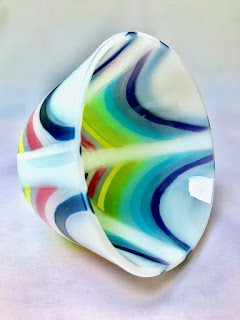Dennis Brady has done a lot of work on predicting the size of circles resulting from stacking squares of glass and taking them to full fuse for enough time to allow flattening of the stacks. This may be up to half an hour at 815°C for Bullseye. Some observation will be required.
Stacks of 12mm/ 0.5" squares arranged at 45° to each other and taken to a full fuse:
- 1 layer should produce a 10mm/ 0.375" circle
- 2 layers should produce a 12mm/0.5" circle
- 3 layers should produce a 16mm/0.6" circle
- 4 layers should produce a 18mm/0.7" circle
- 1 and 2 layers will not fully round
- 3 layers should produce a 28mm/1.1" circle
- 4 layers should produce a 40mm/1.6" circle
- 5 layers should produce a 45mm/1.75" circle
- 6 layers should produce a 50mm/2" circle
- 4 layers should produce a 48mm/1.9" circle
- 5 layers should produce a 52mm/2" circle
- 6 layers should produce a 58mm/2.3" circle
- 4 layers should produce a 40mm/1.6" circle
- 5 layers should produce a 45mm/1.8" circle
- 6 layers should produce a 50mm/2" circle
- 4 layers should produce a 75mm/3" circle
- 5 layers should produce a 85mm/3.3" circle
- 6 layers should produce a 95mm/3.75" circle
- 7 layers should produce a 102mm/4" circle
- 8 layers should produce a 105mm/4.125" circle
I had a few queries about this regular progression and wondered if it applied to opalescent as well as transparent glass. I set up a few tests in my kiln. I fired them at 400C to 815C for 10 minutes.
You can see that the opalescents require more heat work than the transparent. If you are making circles with both transparent and opalescent you will need more time at the top temperature - perhaps 30 to 45 minutes. This results from the greater viscosity of the opalescent colours.
I also tried making ovals from rectangular pieces oriented at about 25 degrees to each other. You can see they were not successful with a 10 minute soak.






























